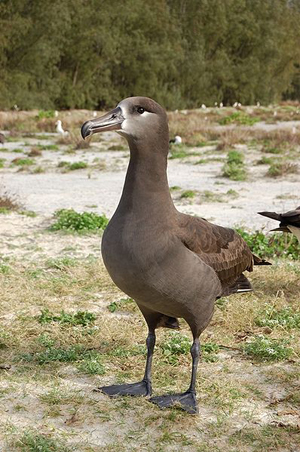Analyzing the feathers of the black-footed albatross (Phoebastria nigripes) going back to 1880. researchers have uncovered rising levels of the toxic methylmercury in the endangered birds that is generally consistent with rising mercury emissions in the Pacific region. Methylmercury is a more toxic compound than mercury that binds with organic molecules when it is released through industrial processes, such as burning coal and other fossil fuels.
“We are starting to find high levels [of methylmercury] in endangered and sensitive species across marine, freshwater, and terrestrial ecosystems, indicating that mercury pollution and its subsequent chemical reactions in the environment may be important factors in species population declines,” explains study co-author Michael Bank, a research associate in the Department of Environmental Health at Harvard School of Public Health (HSPH).
 Black-footed albatross on Sand Island, Midway Atoll. Photo by: James Lloyd. |
To conduct the study, published in the Proceedings of the National Academy of Sciences, researchers analyzed feathers from a number of natural history museums. Feathers from more recent specimens contained higher levels of methylmercury, spiking during the 1990s when mercury emissions in Asia rose considerably.
Listed by the IUCN Red List as Endangered, the black-footed albatross is largely threatened as by-catch by long-line fisheries in the Pacific with at least 4,000 are drowned annually. However, with this new study researchers warn that long-line fisheries may not be the only threat: methylmercury could dampen conservation efforts for the black-footed albatross and many other seabirds.
“Toxicity may undermine reproductive effort in this species and other long-lived, endangered seabirds,” said lead author Anh-Thu Vo, a graduate student at the University of California, Berkeley.
The findings, however, also point to the potential human intake of methylmercury by eating marine fish.
“Much of the mercury pollution issue is really about how much society values wild animal populations, yet we are also faced with the tremendous public health challenge of communicating potential risks from mercury exposure to vulnerable adult and child human populations. Although most people have low or no risk from mercury exposure, for the people who are at risk, for example, from excessive fish consumption, the problem can be considerable,” explained Bank.
Related articles
New seabird discovered, first in 55 years
(03/23/2011) Stephen Maturin, if he were not fictional, would be delighted. A new seabird has been discovered by an international expedition headed by one of the world’s top seabird-experts, Peter Harrison, after he received photos from vacationing birders of an unusual looking storm petrel off the coast of Chile.
Photos: penguins devastated by oil spill

(03/22/2011) Disturbing photos show northern rockhopper penguins (Eudyptes moseleyi) hit hard by an oil spill from a wrecked cargo ship on Nightingale Island in the Southern Atlantic. Already listed as Endangered by the IUCN Red List, the oil spill threatens nearly half of the northern rockhopper population according to BirdLife International. Already conservation workers say ‘hundreds’ of penguins have been oiled. Located the remote Southern Atlantic, Nightingale Island is a part of the UK’s Tristan da Cunha archipelago. The island’s are home to a variety of birdlife, including species that survive no-where else but on the archipelago.
The ocean crisis: hope in troubled waters, an interview with Carl Safina

(02/07/2011) Being compared—by more than one reviewer—to Henry Thoreau and Rachel Carson would make any nature writer’s day. But add in effusive reviews that compare one to a jazz musician, Ernest Hemingway, and Charles Darwin, and you have a sense of the praise heaped on Carl Safina for his newest work, The View from Lazy Point: A Natural Year in an Unnatural World. Like Safina’s other books, The View from Lazy Point focuses on the beauty, poetry, and crisis of the world’s oceans and its hundreds-of-thousands of unique inhabitants. Taking the reader on a journey around the world—the Arctic, Antarctic, and the tropics—Safina always returns home to take in the view, and write about the wildlife of his home, i.e. Lazy Point, on Long Island. While Safina’s newest book addresses the many ways in which the ocean is being degraded, depleted, and ultimately imperiled as a living ecosystem (such as overfishing and climate change) it also tweezes out stories of hope by focusing on how single animals survive, and in turn how nature survives in an increasingly human world. However, what makes Safina’s work different than most nature writing is his ability to move seamlessly from contemporary practical problems to the age-old philosophical underpinnings that got us here. By doing so, he points a way forward.